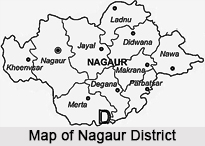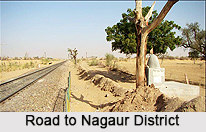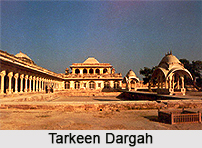 Geography of Nagaur District is a combination of plains, hills and sand mounds as it is a part of the great Thar Desert in India located in West Indian state- Rajasthan.
Geography of Nagaur District is a combination of plains, hills and sand mounds as it is a part of the great Thar Desert in India located in West Indian state- Rajasthan.
Extension of Nagaur District
In terms of size, Nagaur district ranks fifth among the different districts of Rajasthan. The vast terrain of the district spreads over a total area of over 17,718 Sq Kms.
Climate of Nagaur District
The climate of Nagaur district is characterised by a dry climate and hot summer. Generally, one can find in the district extreme dryness, large temperature variations and a highly variable rainfall. Sand storms are quite common in summer. From the month of March to June, the temperature keeps rising steadily. These are therefore the hottest months in the district of Nagaur. The maximum temperature recorded in the district is 47 degrees Celsius with 0 degrees being the lowest recorded temperature. The average temperature of the district is 23.5 degree Celsius. The winter season in the district extends from mid November till the beginning of March. Here, monsoon is of a short duration, from July to mid September. The average rainfall in the district is 36.16 cm and humidity stands at 51.5 percent.
 Geography of Nagaur District
Geography of Nagaur District
The district of Nagaur is poor in forest resources. The total forest area, including hills, is reported to be 240.92 Sq. kms. which is 1.3 percent of the total geographical area of the district. Scanty rainfall and other geographical constraints account for this. The western part of the district is devoid of natural vegetation cover except for low shrubs and grass which grows on low sand dunes. However, the south-eastern part of the district and part of the northern tehsil of Ladnun and Didwana have much more greenery as compared to north-west part of the district. Khejri trees are commonly found in the district. Its leaves are used as fodder. It also gives gum. Apart from commercial value, this tree is considered holy. The tree also plays an important role in checking soil erosion. The other common species found in the district are babul, neem tree, shisham tree, peepul tree, rohira tree, kalsi, dhangood, akara etc. Rohira and shisham trees provide timber and are used for making furniture.

Economy of Nagaur District
Dhangood is generally used for making cots. A common shrub, phog, provides building material from its roots and twigs. Common grass found in the district includes bargers, bhambar and many more.
Agriculture of Nagaur District
The district of Nagaur is mainly agricultural in nature. A majority of the people here are involved in the same. Among the major crops grown here are bajra, wheat, jowar, til, barley and pulses. Other crops grown in the district are taramira, mustard and rape seeds and gram. The major part of the food production is made up of Kharif crops, as agriculture is mainly monsoon-dependent. Kharif crops include bajara, jowar, moong, choula, rice, groundnut, til and guar. Rabi crops are usually sown in November whereas Kharif crops are sown with the beginning of the first rains in July. Industrially, the district is still quite backward on account of the lack of exploitation of natural resources and under developed infrastructural facilities. However this scenario is slowly changing as efforts are being made to improve the industrial scenario of the district.



















